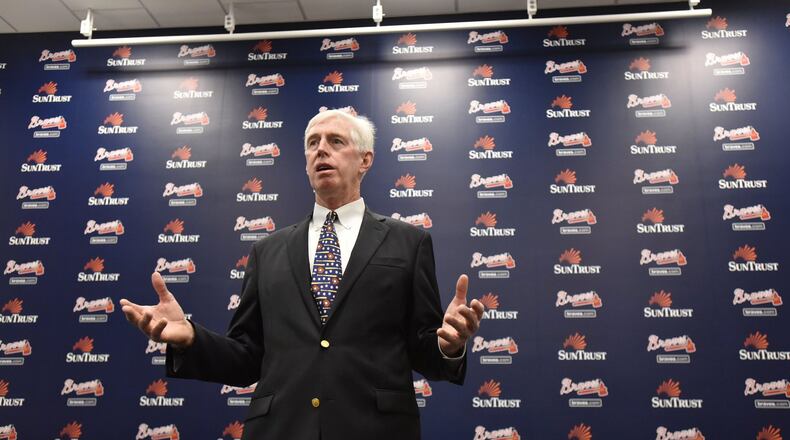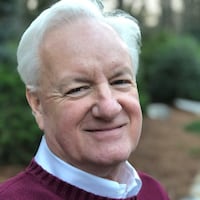Now that the Braves’ new stadium is open and their mixed-use development is up and running, fans may wonder: Will the team’s expected surge in revenue lead to more spending on players?
To a degree, it already has: The Braves opened this season with a player payroll of $126.1 million, up about 45 percent from the start of last season.
But the payroll had been reduced so sharply the past two years that even with this season's increase the Braves rank 17th of 30 MLB teams in spending, according to the Associated Press' annual study of season-opening payrolls.
It’s not clear how much higher the Braves’ payroll will go, or how soon.
Braves Chairman and CEO Terry McGuirk said the stadium and adjacent mixed-use complex, The Battery Atlanta, will provide “economic horsepower” to the franchise. But he also firmly believes that the top-end free-agent market is “incredibly inefficient” and that the correct way to build a team is through deep investment in the minor-league system.
“To the extent that these profits do come, they could be available to build a team, yes,” McGuirk said in an interview in his SunTrust Park office. “I don’t think that we’re going to lack for resources to build the teams of the future at the Atlanta Braves.”
But he added: “Frankly, it’s almost an irrelevancy, bringing more dollars to the top line of building payroll. The real secret sauce right now is our minor league system. Most people (in baseball) would say the pitching we have coming along right now is maybe the best in a generation in one minor-league system.”
The bulk of the Braves’ new spending this past offseason — $32.5 million for one-year commitments to veteran pitchers Bartolo Colon, R.A. Dickey and Jaime Garcia — was intended to patch up the starting rotation without taking on long-term contracts that would overlap the expected arrival of prized pitching prospects.
Such prospects, if they pan out, will be relatively inexpensive for a few years.
“Buying a No. 1 or a No. 2 in your rotation at prices of $30 million and maybe soon $40 million (per year) for five-six years — almost every one of those deals goes bad,” McGuirk said.
Still, even if the Braves’ prospects turn out to be as good as the organization and some outside talent evaluators project, there almost certainly will come a point at which the team needs to turn to the free-agent market to add key pieces that command rich deals.
Perhaps the stadium and The Battery will fund such expenditures.
“What we have done here is a model changer for two things,” McGuirk said. “One, what the fans are going to experience when they get here. But two, the economic horsepower that it provides to a business, to the franchise itself. …
“Time will tell, I think, how the economics work out from a (standpoint of) how much is available to the team and the franchise to help fuel future activity.”
Even McGuirk seems surprised by how much the Braves have built around SunTrust Park: 1.5 million square feet of shops, restaurants, offices, apartments, a concert venue, a hotel.
When team officials began kicking around ideas internally years ago, they initially were thinking in the 100,000-square-foot range for a development, McGuirk recalled.
“We moved past that in lightning speed,” he said. “We were trying to do what we thought would enhance the stadium, enhance the fan experience and make this a big regional destination.
“We had never been in the real estate business before. We are a baseball team. We set out to do this entertainment complex, and the more we got into it we kept expanding because it was economically viable. … We ended up buying 90 acres before we were through. We by no means thought of that when we started this project.”
About a dozen establishments in The Battery are open, including seven eating/drinking places, with another dozen scheduled to open in coming months. In addition, Comcast is scheduled to occupy its office building late in the year, and the Omni hotel is scheduled to open by early next year.
“To do a $500 million-plus mixed-use project, there has to be a lot of capital formation and ROI (return on investment) to all of the participants,” McGuirk said. “All of that takes time, and it will take time. But we would not be at this stage, nor I think with this level of excitement, if this thing wasn’t going to be successful.”
McGuirk said team owner Liberty Media backed the mixed-use project financially.
“Doing the (Braves’ portion of the cost of the) stadium was probably something we could do on our own balance sheet,” McGuirk said. “Moving beyond that, the mixed-use is something we couldn’t, and we were going to have to seek outside investment.
“I did not expect that Liberty should or had to back the whole Battery project. But we brought them the economics and the plans, and they said, ‘Yes, we think this is a smart business opportunity.’ … They’ve basically backed it entirely. All of the equity has come out of Liberty Media basically. We would have gone somewhere else to get that equity. It probably would have been not as good because it wouldn’t have been in the family. But it couldn’t have worked out better.”
McGuirk, who has been involved with the Braves since Ted Turner bought the team in 1976, was asked to quantify the importance in franchise history of opening the stadium and the development.
“Given my view over the history, certainly the Atlanta history, I think it is as important as anything we have ever done,” he said.
ALL ABOUT SUNTRUST PARK
The AJC has been covering various aspects of SunTrust Park all week, including:
Tuesday*: Technology at the ballpark.
Wednesday*: "Social gathering spaces" vs. traditional seats. Also, how the stadium got its name.
Thursday*: How will new ballpark affect attendance?
Friday*: Hitter's park or pitcher's park?
Today: What will stadium and adjacent development mean economically for Braves?
* - Available to read online at MyAJC.com
About the Author
Keep Reading
The Latest
Featured

